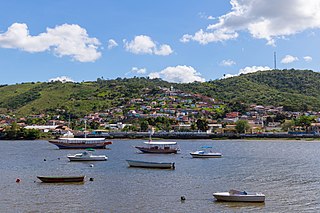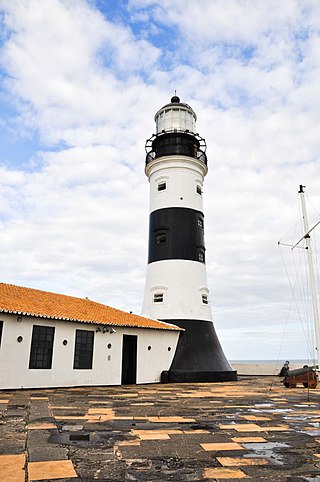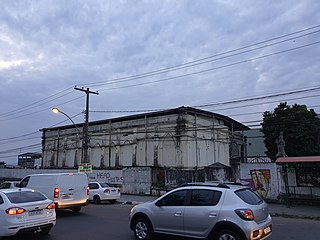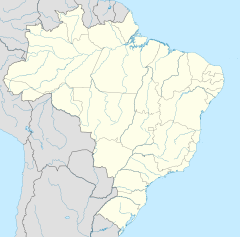
Cachoeira is an inland municipality of Bahia, Brazil, on the Paraguaçu River. The town exports sugar, cotton, and tobacco and is a thriving commercial and industrial centre.

The Archdiocese of São Salvador da Bahia is part of the Roman Catholic Church in Brazil. The Archbishop of São Salvador da Bahia also carries the title Primate of Brazil. The archdiocese is located in the city of Salvador, Bahia.

Barra is a neighborhood located in the south zone of the city of Salvador, Bahia, Brazil. Barra is one of the most traditional neighborhoods of the city, and is also one of the most popular neighborhoods for tourists, with many attractions, like Farol da Barra Lighthouse, Morro do Cristo Hill, Farol da Barra Beach, and Porto da Barra Beach.

The Historic Center (US) or Centre (UK) of Salvador de Bahia in Brazil, also known as the Pelourinho or Pelo, is a historic neighborhood in western Salvador, Bahia. It was the city's center during the Portuguese colonial period and was named for the whipping post in its central plaza where enslaved people from Africa were publicly beaten as punishment for alleged infractions. The Historic Center is extremely rich in historical monuments dating from the 17th through the 19th centuries.

Jacobina is a city in the Centro Norte Baiano mesoregion of Bahia. It was founded July 28, 1722 and the population is 82,590. The town is surrounded by mountains, hills, lakes, rivers, springs, and waterfalls. Located in the northwest region of Bahia, in the extreme north of the Chapada Diamantina, Jacobina is 330 kilometers from Salvador and is also known as 'City of Gold', a legacy of the gold mines which attracted the pioneers from São Paulo in the early seventeenth century.

São Félix, Bahia is a municipality in Bahia, Brazil. The municipality has a population of 14,762 with a population density of 142 inhabitants per square kilometer. It is located 110 km (68 mi) from the state capital of Bahia, Salvador.

Events in the year 1899 in Brazil.

Events in the year 1891 in Brazil.

Events in the year 1890 in Brazil.

Events in the year 1889 in Brazil.
Lindalva Justo de Oliveira, DC was a Brazilian Catholic member of the Daughters of Charity of Saint Vincent de Paul. Oliveira worked at Dom Pedro II Home, a retirement facility, where she was killed in 1993 after a man obsessed with her stabbed her 44 times when she refused his advances.

Forte de Santo Antônio da Barra is a fort located in Salvador, Bahia, Brazil. It was constructed to guard the entrance to the Bay of All Saints, during the time of the Portuguese Empire. The first Portuguese fortification erected in Bahia was likely built in 1501, in the same area now occupied by the Forte de Santo Antônio da Barra. The foundation stone of that first fortification was placed in an area called Ponta do Padrão, now known as the Largo do Farol da Barra, the broad public square in front of the fort. The fort also houses the 22 metres (72 ft)-high Barra Lighthouse and the Nautical Museum of Bahia. The Santo Antônio da Barra Fort is protected as a historic structures by the National Institute of Historic and Artistic Heritage.

Forte de Santo Antônio Além do Carmo is a fort located in Salvador, Bahia, Brazil. It is variously known as the Forte da Capoeira, State Prison. The fort defended the northern limit of Salvador at its time of construction 17th century.

The Church of the Third Order of Mount Carmel is an 18th-century Roman Catholic church in Salvador, Bahia, Brazil. It is located adjacent to the Church and Convent of Our Lady of Mount Carmel. Work on the church began in 1644. It was destroyed by fire in 1788 and subsequently rebuilt. The church is a large complex consisting of a nave, chancel, choir, corridors, tribunes, meeting rooms, and a sacristy. The interior was richly decorated in the 18th century; the painting of the ceiling of the nave is the first major work by José Teófilo de Jesus. The Church of the Third Order of Mount Carmel was listed as a historic structure by National Institute of Historic and Artistic Heritage (IPHAN) in 1938 and is part of the Historic Center of Salvador UNESCO World Heritage Site.
Nazaré is a neighborhood in the city of Salvador, Bahia, Brazil. The region of present-day Nazaré was chiefly rural until the 19th century. It developed below the Historic Center of the city around the freguesias, or historical settlements of São Pedro, Santana do Sacramento, and later, Nossa Senhora de Brotas. Avenida Joana Angélica, a broad avenue, crosses the neighborhood from north-east to south-west. The avenue is named for Joana Angélica, a Brazilian Conceptionist nun and martyr of Brazilian Independence. Joana Angélica was stabbed by a bayonet at the Convent of Lapa by Portuguese colonial troops. Nazaré is home to numerous historic structures of the city; it is additionally home of several government and academic centers.

The Constituent Cortes of 1820, formal title The General and Extraordinary Cortes of the Portuguese Nation, also frequently known as the Sovereign Congress or the Cortes Constituintes Vintistas, was the first modern Portuguese parliament. Created after the Liberal Revolution of 1820 to prepare a constitution for Portugal and its overseas territories, it used a different system from the traditional General Cortes for choosing representatives, and the three traditional feudal estates no longer sat separately. The Cortes sat between January 24, 1821 and November 4, 1822 at the Necessidades Palace in Lisbon. The work of the Constitutional Cortes culminated in the approval of the Portuguese Constitution of 1822.

The Queimado Fountain is an abandoned fountain in Salvador, Bahia, Brazil. The fountain is located at the Largo do Queimado, a broad public square, below the Church and Convent of Our Lady of Solitude. The fountain likely dates to the early 19th century and is one of a series of fountains built along the escarpment of the historical center of Salvador. It consists of a broad brick area and glazed tile facade with a triangular pediment. The fountain was listed as a historic structure by the Artistic and Cultural Heritage Institute of Bahia in 1984.

The São Paulo da Gamboa Battery is a military fortification located in Salvador, Bahia in Brazil. It is also known as the Fort of São Paulo da Gambôa, or simply the Fort of Gambôa. The battery was built in the early 17th century as part of a series of military fortifications in Salvador by Jean Massé, a French military engineer. The battery was built as an extension of the Fort of Saint Peter; it functioned to defend the city against Dutch and French attacks. The battery was listed as a historic structure by the National Institute of Historic and Artistic Heritage (IPHAN) in 1938. Despite its listing as a federal historic structure, it is not under the care of any public agency or institution. The battery is in an advanced state of disrepair, occupied by informal settlements, and is below a slope prone to landslides.

The Barra Lighthouse also known as the Santo Antônio Lighthouse, is a lighthouse in Salvador, Bahia, Brazil. It is located at the tip of the Padrão, now the Point of Santo Antônio, to the extreme south of Salvador, at the entrance of the Bay of All Saints. The lighthouse was built at the center of the Santo Antônio da Barra Fort.

The Building of the Santa Casa de Misericórdia of Feira de Santana is an 18th-century mansion and medical building in Feira de Santana, Bahia, Brazil. It was established in the Portuguese colonial period as a branch of the Santa Casa da Misericórdia, a lay Portuguese organization to treat the sick and disabled. The building was listed as a state heritage site by the Institute of Artistic and Cultural Heritage of Bahia in 2008.


















